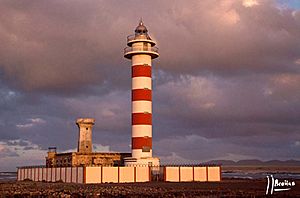Tostón Lighthouse facts for kids
| Location | El Cotillo Fuerteventura Canary Islands Spain |
|---|---|
| Coordinates | 28°42′56″N 14°00′50″W / 28.715561°N 14.013810°W |
| Year first constructed | 1897 (first) 1950s (second) |
| Year first lit | 1986 (current) |
| Deactivated | 1986 (second) |
| Construction | concrete tower (current) |
| Tower shape | cylindrical tower with double balcony and lantern (current) |
| Markings / pattern | red and white bands, grey lantern dome (current) |
| Height | 30 metres (98 ft) (current) 7 metres (23 ft) (first) 15 metres (49 ft) (second) |
| Focal height | 35 metres (115 ft) |
| Range | 17 nautical miles (31 km; 20 mi) |
| Characteristic | Fl W 8s. |
| Spain number | ES-12220 |
The Tostón Lighthouse (also called Faro de Tostón in Spanish) is an important lighthouse on the Canary island of Fuerteventura. It is also known as the El Cotillo Lighthouse. You can find it on the northwest coast of the island, close to the village of El Cotillo. This lighthouse helps guide ships through the narrow La Bocayna strait. This strait is a water passage that separates Fuerteventura from the nearby island of Lanzarote. The Tostón Lighthouse works together with the lights at Pechiguera and Punta Martiño to keep ships safe.
Lighthouse History
The Tostón Lighthouse you see today is actually the third lighthouse built in this spot. This area is called Punta Tostón, or sometimes Punta de la Ballena (which means "Whale Point").
The very first lighthouse opened in 1897. It was a simple stone tower, about 7 meters (23 feet) tall. It stood on one corner of the lighthouse keeper's house.
In the 1950s, a new, taller tower was built. This one was made of concrete and was about 15 meters (49 feet) high. But even this second tower was later replaced.
The lighthouse that stands there now was built in the 1980s. It is a very noticeable concrete tower, 30 meters (98 feet) tall. It is painted white with bright red bands. Its light shines from 35 meters (115 feet) above the sea. This powerful light can be seen from about 14 nautical miles away. It flashes a white light every eight seconds.
What You Can See and Do
The original house where the lighthouse keepers lived has been updated. It is now a museum with a small café. At the museum, you can learn about the traditional fishing methods used on the island. You can also climb to the top of the second concrete tower from the 1950s.
There is a short walking path, about 1 kilometer (0.6 miles) long, that goes around the lighthouse. Along the path, there are signs in different languages. These signs tell you about the rocks, seashells, and animals that live on the headland. One interesting thing to see is the Aljibe. This is a special system for collecting water, located near the road to the lighthouse. It used to provide drinking water for the lighthouse keepers and their families.
See also
- List of lighthouses in Spain
- List of lighthouses in the Canary Islands
 In Spanish: Faro Tostón para niños
In Spanish: Faro Tostón para niños


